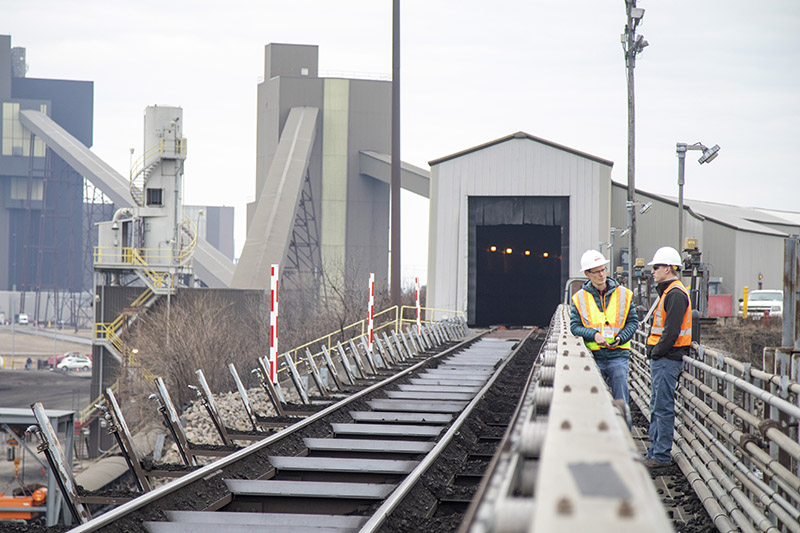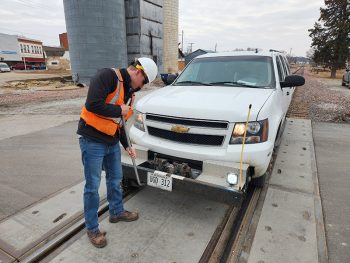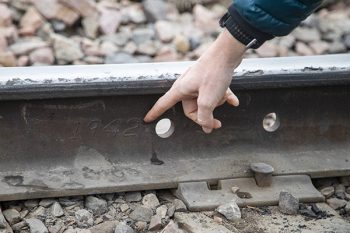Rail line helps OPPD ensure reliability

Brennan Fowler turns his Chevy Suburban onto a railroad crossing in Dunbar, Nebraska, and centers all four wheels on the track.
Five minutes later, after lowering the SUV’s train-track wheels into position and completing some final safety checks, OPPD’s senior rail manager is cruising westbound on a country rail line to Syracuse – all to ensure reliable, affordable power in eastern Nebraska.
Fowler, a civil engineer, never imagined himself driving down train tracks to inspect lines and oversee maintenance.

But OPPD owns and operates 60 total miles of rail line, mostly from Lincoln to its Nebraska City Station (NCS) coal plant, plus shorter stretches at North Omaha Station (NOS) and OPPD’s Elkhorn Service Center. Regular upkeep is critical.
“I enjoy being able to come down here,” Fowler said. “Every day is different, and there are always challenges that you have to work through. It breaks up the monotony of going into the office.”
OPPD bought the line from Burlington Northern Santa Fe (BNSF) in 1997, gaining access to a storied railway that has carried cargo since the 1800s.
The utility owns nearly 1,000 coal cars as well to help reduce shipping costs. BNSF hauls the cars with its locomotives across the state to Nebraska City Station. Union Pacific (UP) locomotives carry some loads as well on shorter stretches of OPPD track.
“It’s important for us to own our own lines because it allows access for both UP and BNSF, which helps keep transportation costs competitive,” said Preston Barrett, an OPPD Fuels Supply manager.
Inspecting the rail line
On the tracks with his steering wheel locked in place, Fowler looks for subtle issues.
Nebraska’s famously wild weather puts a lot of stress on the rails. As they heat and expand in the summer, the track can appear wavy and start to curve or buckle.
Fowler works with contracted crews to ensure a safe, smooth ride for OPPD’s coal cars as they arrive from Wyoming’s Powder River Basin. The coal they carry helps run generators that supply power for OPPD customers.

“The rails love to move,” Fowler said. “When they heat up, they have to run somewhere, so they tend to run in or out. It’s a constantly ongoing work in progress. There are always little upgrades being made.”
Equally important is tracking how much coal OPPD will need at NCS and NOS so the utility can budget accordingly. Fowler works under OPPD’s Energy Marketing and Trading team, which forecasts the utility’s needs and helps ensure a reliable fuel supply for every generating station. He also coordinates with OPPD’s asset management team, which helps maintain plants and other infrastructure.
“Obviously, getting coal to a plant is such a critical part of their operations and a core part of what we do to generate electricity,” Fowler said.
Always busy
Driving on the track requires careful safety procedures, good communication and a thorough checklist. Weather? Good. Nearest hospital? Syracuse General in Otoe County. Who else is on the track? Where are they located?
Fowler double-checks his permissions and verifies which stretch of the line he can safely access. At every road intersection and farm crossing, he stops and looks for motorists. The special, hy-rail wheels on his SUV are beveled inward and ride on the inside of the tracks to keep them balanced through every turn.
Trains run 24 hours a day, seven days a week, between OPPD’s facilities and Wyoming. OPPD keeps contractors on site to help maintain and repair the line and respond to issues quickly.
Greater flexibility
OPPD’s need for coal varies based on dozens of factors. Is energy demand high? Does the utility have a unit down for routine maintenance? Is a breezy day generating enough wind energy to meet customer needs at the moment?
Delivering the right amount requires careful planning and coordination with plant supervisors, station managers, energy marketers and many others.

OPPD tracks trains in real time as they roll toward the plants. Train cars can drop coal directly into a plant for immediate needs or into nearby piles to use later.
“It’s a team effort,” said Michael Kelch, Material Handling supervisor at Nebraska City Station. “We make sure we stock out enough coal to run the units and we make room for the trains and shipments coming in.”
Sometimes, depending on needs and when it makes sense to do so, OPPD will divert coal cars to a different generating station.
“As long as we let BNSF know within a reasonable time, they can accommodate us,” Fowler said. “That’s why we work so closely with the plants, so we can project any scheduled outages and our needs.”
Other opportunities
Once OPPD burns the coal to generate electricity, the utility sells the leftover ash to customers for use in concrete, paving projects, soil stabilization and other environmentally safe applications. State Departments of Transportation are frequent buyers, helping OPPD recover some of its costs.
“It’s pretty important for us to remain environmentally sensitive,” Barrett said.
Fowler also works with OPPD’s design engineering team, which is responsible for replacing older railroad bridges on the line. As an engineer interested in structures, that work appeals to him as well.
“The good thing about civil engineering is the breadth is very wide,” Fowler said.

Grant Schulte joined OPPD as a content generalist in 2022. He is a former reporter for The Associated Press, where he covered the Nebraska Legislature, state politics and other news for a global audience. He is a graduate of the University of Iowa and a proud Hawkeye. In his free time he enjoys running, reading, spending time with his wife, and all things aviation.
View all posts by Grant Schulte >







